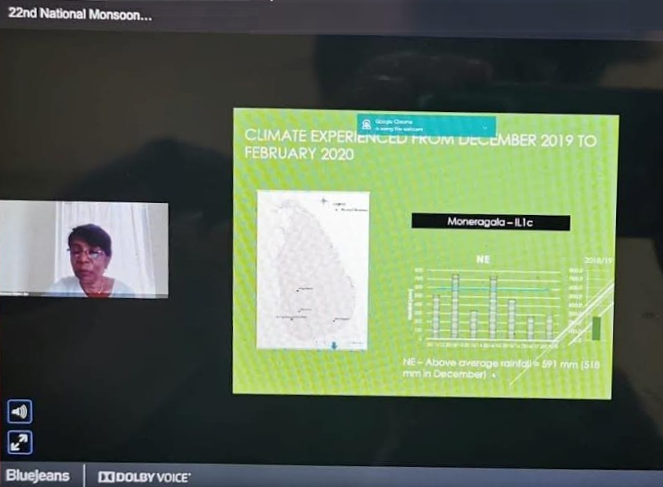Fifty-four Monsoon Forum stakeholders in Sri Lanka met on 29 April 2020 to review the performance of climate-sensitive sectors during the past second inter-monsoon season and northeast monsoon season, and to draw sectoral preparedness plans in anticipation of the predicted above-normal rainfall for the 2020 southwest monsoon season. The 22nd Monsoon Forum was held online, convened by the Department of Meteorology (DOM).
Rainfall during the second inter-monsoon season (October to November 2019) was above the climatological average (or above normal), consistent with DOM’s forecast that was issued during the 21st Monsoon Forum. The northeast monsoon season (December 2019 to February 2020) was generally marked by above-average rainfall in December, but below-average rainfall in January and February. Below-average rainfall persisted until March, the initial month of the first inter-monsoon season (March to April 2020). The period covering September to March is the Maha cultivation season in Sri Lanka.
The Maha season started in September 2019 with extremely low water levels in major reservoirs, which caused problems in meeting water requirements, including for drinking water. Thus, even with DOM’s forecast for October to November of above average rainfall, the Department of Irrigation (DOI) advised for delayed planting. Based on this, the Department of Agriculture (DOA) also advised farmers to plant 3.5-month rice varieties. In November, reservoirs were 40% full; in December, they were 70% full, and Maha cultivation was started. Although the season was marked by a flooding event in late December, DOA reported a successful Maha season, with sown extent that is over 50% higher than the average for the last three Maha seasons.
For the rubber subsector, the Rubber Research Institute (RRI) recorded high yield in the country’s wet climatological zone (south to southwest of the country). In the intermediate zone (central to western part of the country), however, seedlings were kept in nurseries (for use in the next season) due to drought conditions experienced during the season. For the tea subsector, the Tea Research Institute (TRI) reported reduced yields/ plant deaths in low-elevation cultivation areas, due to very low rainfall and temperatures of above 35oC. This required the government to provide compensation to affected tea farmers.

Dr. Wasana Wijesuriya of the Rubber Research Institute presented the subsector’s rainfall experience during the northeast monsoon season
In the hydropower sector, Ceylon Electricity Board (CEB) shared that rainfall received in the catchments was not adequate for the required drawdown to meet power demand. Thankfully, reduced demand from mid-March due to lockdown and curfew associated with the COVID-19 health emergency restricted water drawdown. For the disaster management sector, the Disaster Management Center (DMC) reported on their responses to drought, flood, landslide, and strong wind emergencies during the Maha season. The Department of Fisheries (DOF), on the other hand, shared that there were no major incidents during the season, as they were able to provide early warning and evacuated multi-day fishing vessels, based on extreme weather forecasts from DOM.
DOM issued the seasonal outlook for the southwest monsoon, covering the period May-September 2020, which effectively covers the Yala cultivation season (May to August). Above-normal rainfall (i.e. above the climatological average) was predicted for the season.

Climate outlook for the southwest monsoon season for rainfall (left), maximum temperature (middle) and minimum temperature (right)
Based on the outlook for the season, Forum participants evaluated potential impacts on respective sectors and came up with the following preparedness plans:
- Agriculture sector: Seasonal planning for the sector was undertaken earlier than the Forum, using DOM’s forecast for the first inter-monsoon season and based on observed Mahaweli reservoir levels, which were at 60% to 70% only of water levels of previous Yala seasons. Cultivation was already started, with focus on other field crops. The predicted above-normal rainfall for the southwest monsoon season would, thus, greatly benefit the sector. For the rubber subsector, rain guards would be required to increase tapping days, and precautions against pests and diseases would be needed due to anticipated increased moisture during the season.
- Water sector: Entering the southwest monsoon season with high water levels in reservoirs, the predicted above-normal rainfall during the season could pose flooding threat. Close water level monitoring in reservoirs would be mandatory to evaluate for any need to release water.
- Disaster management sector: The seasonal outlook guides the sector to be in a state of preparedness. Short- and medium-range forecasts within the season shall inform the issue of warnings. It was noted that an integrated approach would be needed for emergency response, in light of the ongoing COVID-19 pandemic.
The Monsoon Forum also receives stakeholder recommendations to improve the delivery and application of climate services and multi-hazard early warning, as well as monitor actions on these recommendations. This active stakeholder involvement has greatly contributed to DOM’s delivery of user-relevant products and services that have already led to socio-economic benefits in participating sectors.